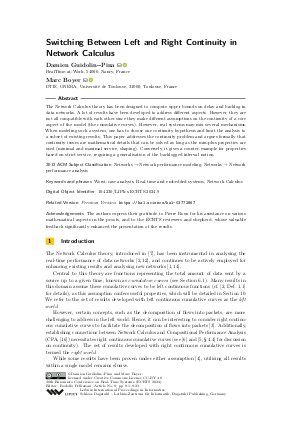Switching Between Left and Right Continuity in Network Calculus
Authors
Damien Guidolin--Pina  ,
Marc Boyer
,
Marc Boyer 
-
Part of:
Volume:
36th Euromicro Conference on Real-Time Systems (ECRTS 2024)
Part of: Series: Leibniz International Proceedings in Informatics (LIPIcs)
Part of: Conference: Euromicro Conference on Real-Time Systems (ECRTS) - License:
 Creative Commons Attribution 4.0 International license
Creative Commons Attribution 4.0 International license
- Publication Date: 2024-07-04
File

PDF
LIPIcs.ECRTS.2024.9.pdf
- Filesize: 0.82 MB
- 23 pages
Document Identifiers
Related Versions
- Previous Version https://hal.science/hal-03772867
Subject Classification
ACM Subject Classification
- Networks → Network performance modeling
- Networks → Network performance analysis
Keywords
- Worst-case analysis
- Real-time and embedded systems
- Network Calculus
Metrics
- Access Statistics
-
Total Accesses (updated on a weekly basis)
0PDF Downloads0Metadata Views
Abstract
The Network Calculus theory has been designed to compute upper bounds on delay and backlog in data networks. A lot of results have been developed to address different aspects. However, they are not all compatible with each other since they make different assumptions on the continuity of a core aspect of the model (the cumulative curves). However, real systems may mix several mechanisms. When modeling such a system, one has to choose one continuity hypothesis and limit the analysis to a subset of existing results. This paper addresses the continuity problem and argues formally that continuity issues are mathematical details that can be solved as long as the min-plus properties are used (minimal and maximal service, shaping). Conversely, it gives a counter-example for properties based on strict service, requiring a generalisation of the backlogged interval notion.
Cite As Get BibTex
Damien Guidolin--Pina and Marc Boyer. Switching Between Left and Right Continuity in Network Calculus. In 36th Euromicro Conference on Real-Time Systems (ECRTS 2024). Leibniz International Proceedings in Informatics (LIPIcs), Volume 298, pp. 9:1-9:23, Schloss Dagstuhl – Leibniz-Zentrum für Informatik (2024)
https://doi.org/10.4230/LIPIcs.ECRTS.2024.9
BibTex
@InProceedings{guidolinpina_et_al:LIPIcs.ECRTS.2024.9,
author = {Guidolin--Pina, Damien and Boyer, Marc},
title = {{Switching Between Left and Right Continuity in Network Calculus}},
booktitle = {36th Euromicro Conference on Real-Time Systems (ECRTS 2024)},
pages = {9:1--9:23},
series = {Leibniz International Proceedings in Informatics (LIPIcs)},
ISBN = {978-3-95977-324-9},
ISSN = {1868-8969},
year = {2024},
volume = {298},
editor = {Pellizzoni, Rodolfo},
publisher = {Schloss Dagstuhl -- Leibniz-Zentrum f{\"u}r Informatik},
address = {Dagstuhl, Germany},
URL = {https://drops.dagstuhl.de/entities/document/10.4230/LIPIcs.ECRTS.2024.9},
URN = {urn:nbn:de:0030-drops-203129},
doi = {10.4230/LIPIcs.ECRTS.2024.9},
annote = {Keywords: Worst-case analysis, Real-time and embedded systems, Network Calculus}
}
Author Details
Acknowledgements
The authors express their gratitude to Pierre Roux for his assistance on various mathematical aspects in the proofs, and to the ECRTS reviewers and shepherd, whose valuable feedback significantly enhanced the presentation of the results.
References
- Steffen Bondorf and Jens B. Schmitt. Should network calculus relocate? an assessment of current algebraic and optimization-based analyses. In Proceedings of the International Conference on Quantitative Evaluation of Systems (QEST 2016), August 2016. URL: https://disco.cs.uni-kl.de/discofiles/publicationsfiles/BS16-1.pdf.
-
Anne Bouillard, Marc Boyer, and Euriell Le Corronc. Deterministic network calculus: From theory to practical implementation. Wiley-ISTE, 2018.

-
Anne Bouillard, Nadir Farhi, and Bruno Gaujal. Packetization and aggregate scheduling. Technical Report 7685, INRIA, 2011.

-
Marc Boyer, Guillaume Dufour, and Luca Santinelli. Continuity for network calculus. In Proceedings of the 21st International conference on Real-Time Networks and Systems, pages 235-244, 2013.

- Marc Boyer and Pierre Roux. A common framework embedding network calculus and event stream theory. working paper or preprint, May 2016. URL: https://hal.archives-ouvertes.fr/hal-01311502.
-
Marc Boyer and Pierre Roux. Embedding network calculus and event stream theory in a common model. In 2016 IEEE 21st International Conference on Emerging Technologies and Factory Automation (ETFA), pages 1-8. IEEE, 2016.

- Rene L. Cruz. A calculus for network delay, part I: Network elements in isolation. IEEE Transactions on information theory, 37(1):114-131, January 1991. URL: https://doi.org/10.1109/18.61109.
-
Markus Fidler and Jens B Schmitt. On the way to a distributed systems calculus: An end-to-end network calculus with data scaling. In Proceedings of the joint international conference on Measurement and modeling of computer systems, pages 287-298, 2006.

- Damien Guidolin-Pina and Marc Boyer. Looking for equivalences of the services between left and right continuity in the Network Calculus theory. Technical Report, September 2022. URL: https://hal.archives-ouvertes.fr/hal-03772867.
-
Leonie Köhle, Borislav Nikolić, and Marc Boyer. Increasing accuracy of timing models: From CPA to CPA+. In Proc. of the Design, Automation and Test in Europe Conference and Exhibition (DATE), Florence, Italy, March 2019.

-
Anurag Kumar, D Manjunath, and Joy Kuri. Communication networking: an analytical approach. Academic Press, 2004.

-
Jean-Yves Le Boudec and Patrick Thiran. Network calculus: a theory of deterministic queuing systems for the internet. Springer, 2001.

-
Jörg Liebeherr et al. Duality of the max-plus and min-plus network calculus. Foundations and Trends in Networking, 11(3-4):139-282, 2017.

-
Lisa Maile, Kai-Steffen Hielscher, and Reinhard German. Network calculus results for TSN: An introduction. In Proc. of the Information Communication Technologies Conference (ICTC 2020), pages 131-140. IEEE, 2020.

-
Victor Pollex and Frank Slomka. A mathematical comparison between response-time analysis and real-time calculus for fixed-priority preemptive scheduling. In 34th Euromicro Conference on Real-Time Systems (ECRTS 2022). Schloss Dagstuhl - Leibniz-Zentrum für Informatik, 2022.

-
Jonas Rox and Rolf Ernst. Compositional performance analysis with improved analysis techniques for obtaining viable end-to-end latencies in distributed embedded systems. International Journal on Software Tools for Technology Transfer, 15(3):171-187, 2013.

